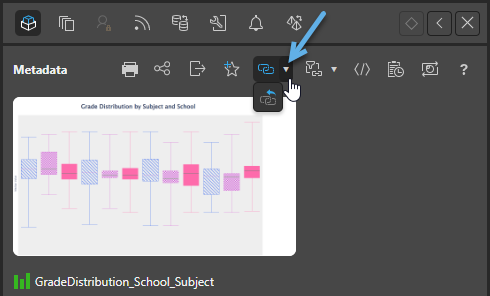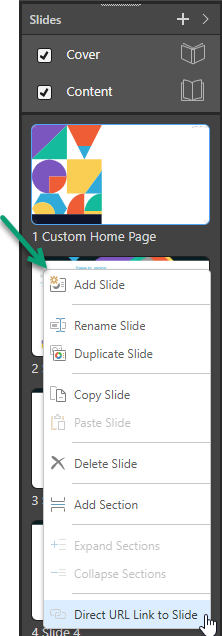Discover, Present, and Publish content can be loaded DIRECTLY in a viewer or runtime viewer using a specific URL for the relevant content item. Direct URL loading lets your users open content (visualizations, presentations, and publications) by giving them direct access to relevant analytics. It allows them to access the content without navigating the Pyramid application in either pro mode or viewer mode.
Tip: You can also direct link to a Folder, although the linked folder will open in the Content Manager and not in a standard browser.
Note: URL loading is designed to open content in a standalone browser window. For content hosted in another page, we recommend content embedding techniques instead.
General Syntax
The following basic URL syntax is required when loading content using a URL:
{YourPyramidSite}/direct/?id={content identifier}{YourPyramidSite}is the main address of your pyramid installation. For example,https://pyramid.acme.com. If you are using a port for your website, it will be something likehttp://pyramid.acme.com:8181.{content identifier}is the 32 character UUID (or GUID) of the relevant content item. This can be found in the metadata panel in the content explorer (see below for details).
Parameterization
The optional &backToApp parameter indicates that users with this URL should be able to close the loaded asset and 'go back' to the main Pyramid:
{YourPyramidSite}/direct/?id={content identifier}&backToAppNote: The &backToApp parameter is included in your URL automatically when you select Direct URL Link with Back Option.
Presentation Parameters
When you click Direct URL Link to Slide for a selected slide in Present, a URL is copied to your clipboard that includes the content identifier for the presentation and a slideNumber parameter. These values are used in combination to indicate which slide in the presentation should be shown to the viewer by default.
{YourPyramidSite}/direct/?id={content identifier}&slideNumber={#}If the slide at the linked location is deleted (your link is to slideNumber six and now your presentation only has five slides), you will be taken to the home page for the presentation when you click the link.
If the entire presentation is deleted, clicking the link will cause an error.
External Parameters
Content items that are loaded directly using a URL can be further parameterized using the following syntax:
{YourPyramidSite}/direct/?id={content identifier}&filter=member1&filter=member2....&filter=memberxFor example, add a background filter that shows a single value slicer:
{YourPyramidSite}/direct/?id={content identifier}&filter=[customerProfile].[Gender].[Male]- Click here for more about parameterization in URL loading and embedding.
Note: The extended parameterization does not apply to folder links.
Finding Content IDs
You can get the Direct URL links and Content IDs that can be used to access your content items from the Metadata panel in the Content Manager, the Extensions option on the App Tabs context menu, and, in Present, the right-click menu in the Slides panel. You can also use the REST API to return content IDs and use them programmatically.
By default, direct URL loading allows the user to view the given asset only.
Direct URL Links from Metadata Panel
- Direct URL Link - Copies the full link to open the presentation or visual to your clipboard. This URL can then be used to access the item in a browser.
- Direct URL Link > Direct URL Link with Back Option (drop-down, blue arrow) Copies the same URL link to your clipboard but includes the
&backToAppparameter in the URL. This parameter allows users closing the loaded asset to "go back" to the main Pyramid app. When the user closes the given content item, it is opened in the relevant editor; for example, a presentation is opened in edit mode in Present.
Note: You can access the Metadata panel by clicking the Actions option or the Metadata option in Content Explorer.

Direct URL Links from App Tabs
In Present Pro or Discover Pro, you can open the content item's App Tab menu (green arrow below) and copy one of the links from the Extensions menu (purple highlight). The options are:
- Direct URL Link
- Direct URL Link with Back Option
In Present Lite or Discover Lite, you can access the Direct URL Link option from the content item's App Tab menu. (There is no extensions sub-menu.)

Direct URL Links from Slides Panel (Present Only)
In Present Pro and Present Lite, the Slides panel includes the context menu option Direct URL Link to Slide. This option copies the URL link to your clipboard as described above, but additionally includes the &slideNumber parameter in the URL. The slideNumber parameter indicates which slide should be shown first when the presentation is opened using the direct link.

Content IDs from Content Manager and App Tabs
In addition to getting the full direct URL link (described above), you can also get the {content identifier} from the content item in the same places:
- In the Metadata panel, click Copy (blue, above) to copy the {content identifier} for your content item to your clipboard.
- Alternatively, from the App Tabs, click Extensions > Copy Item ID (also blue).
Content IDs from REST API
You can also use the REST API framework to find the relevant item, return its ID and use it programmatically in your application. There are numerous functions that will return the IDs, including search. This is particularly useful for dynamic content embedding scenarios.